roof LINCOLN MKC 2016 Owners Manual
[x] Cancel search | Manufacturer: LINCOLN, Model Year: 2016, Model line: MKC, Model: LINCOLN MKC 2016Pages: 432, PDF Size: 4.89 MB
Page 5 of 432
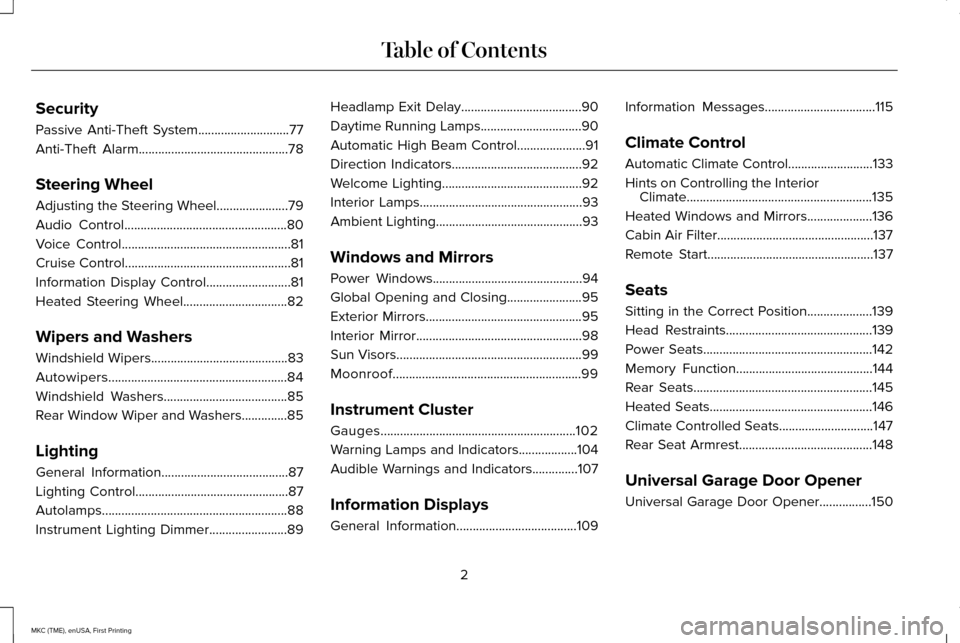
Security
Passive Anti-Theft System............................77
Anti-Theft Alarm..............................................78
Steering Wheel
Adjusting the Steering Wheel......................79
Audio Control..................................................80
Voice Control
....................................................81
Cruise Control...................................................81
Information Display Control
..........................81
Heated Steering Wheel
................................82
Wipers and Washers
Windshield Wipers
..........................................83
Autowipers.......................................................84
Windshield Washers
......................................85
Rear Window Wiper and Washers..............85
Lighting
General Information
.......................................87
Lighting Control
...............................................87
Autolamps.........................................................88
Instrument Lighting Dimmer........................89 Headlamp Exit Delay.....................................90
Daytime Running Lamps...............................90
Automatic High Beam Control.....................91
Direction Indicators
........................................92
Welcome Lighting
...........................................92
Interior Lamps
..................................................93
Ambient Lighting
.............................................93
Windows and Mirrors
Power Windows
..............................................94
Global Opening and Closing.......................95
Exterior Mirrors................................................95
Interior Mirror
...................................................98
Sun Visors
.........................................................99
Moonroof..........................................................99
Instrument Cluster
Gauges............................................................102
Warning Lamps and Indicators..................104
Audible Warnings and Indicators..............107
Information Displays
General Information
.....................................109 Information Messages
..................................115
Climate Control
Automatic Climate Control..........................133
Hints on Controlling the Interior Climate.........................................................135
Heated Windows and Mirrors....................136
Cabin Air Filter................................................137
Remote Start
...................................................137
Seats
Sitting in the Correct Position....................139
Head Restraints
.............................................139
Power Seats
....................................................142
Memory Function
..........................................144
Rear Seats
.......................................................145
Heated Seats..................................................146
Climate Controlled Seats.............................147
Rear Seat Armrest.........................................148
Universal Garage Door Opener
Universal Garage Door Opener................150
2
MKC (TME), enUSA, First Printing Table of Contents
Page 6 of 432
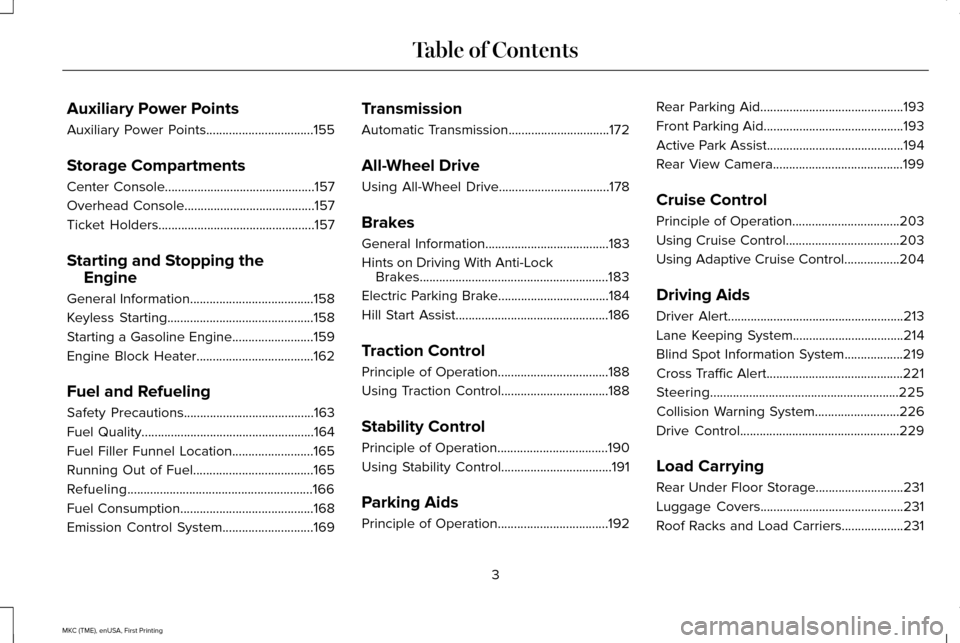
Auxiliary Power Points
Auxiliary Power Points.................................155
Storage Compartments
Center Console..............................................157
Overhead Console........................................157
Ticket Holders
................................................157
Starting and Stopping the Engine
General Information......................................158
Keyless Starting
.............................................158
Starting a Gasoline Engine.........................159
Engine Block Heater....................................162
Fuel and Refueling
Safety Precautions
........................................163
Fuel Quality
.....................................................164
Fuel Filler Funnel Location.........................165
Running Out of Fuel.....................................165
Refueling.........................................................166
Fuel Consumption.........................................168
Emission Control System
............................169 Transmission
Automatic Transmission
...............................172
All-Wheel Drive
Using All-Wheel Drive
..................................178
Brakes
General Information
......................................183
Hints on Driving With Anti-Lock Brakes..........................................................183
Electric Parking Brake..................................184
Hill Start Assist...............................................186
Traction Control
Principle of Operation..................................188
Using Traction Control.................................188
Stability Control
Principle of Operation
..................................190
Using Stability Control..................................191
Parking Aids
Principle of Operation
..................................192 Rear Parking Aid............................................193
Front Parking Aid...........................................193
Active Park Assist..........................................194
Rear View Camera........................................199
Cruise Control
Principle of Operation.................................203
Using Cruise Control...................................203
Using Adaptive Cruise Control.................204
Driving Aids
Driver Alert......................................................213
Lane Keeping System..................................214
Blind Spot Information System..................219
Cross Traffic Alert..........................................221
Steering..........................................................225
Collision Warning System..........................226
Drive Control.................................................229
Load Carrying
Rear Under Floor Storage...........................231
Luggage Covers
............................................231
Roof Racks and Load Carriers...................231
3
MKC (TME), enUSA, First Printing Table of Contents
Page 32 of 432
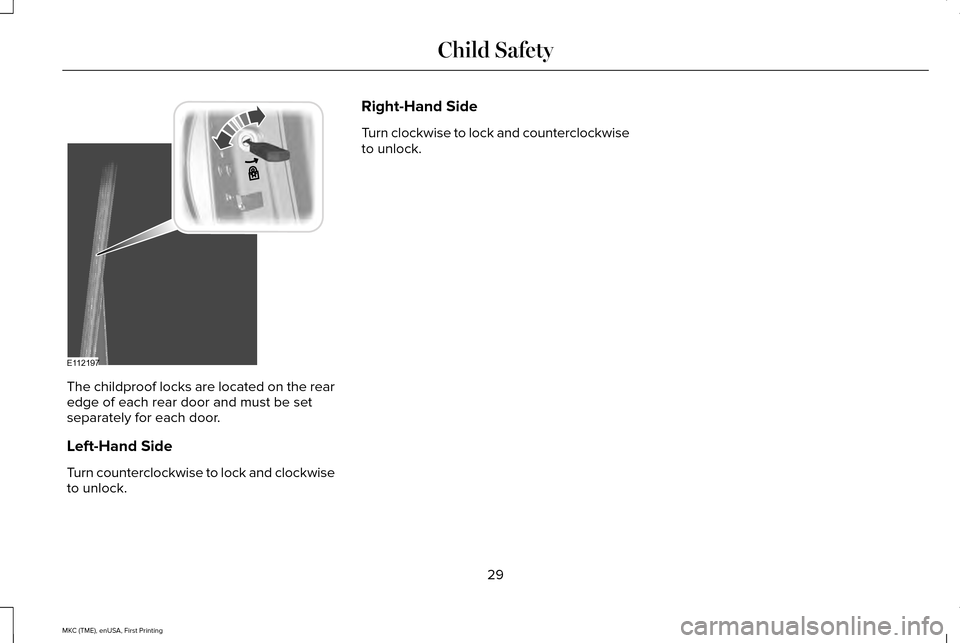
The childproof locks are located on the rear
edge of each rear door and must be set
separately for each door.
Left-Hand Side
Turn counterclockwise to lock and clockwise
to unlock. Right-Hand Side
Turn clockwise to lock and counterclockwise
to unlock.
29
MKC (TME), enUSA, First Printing Child SafetyE112197
Page 51 of 432
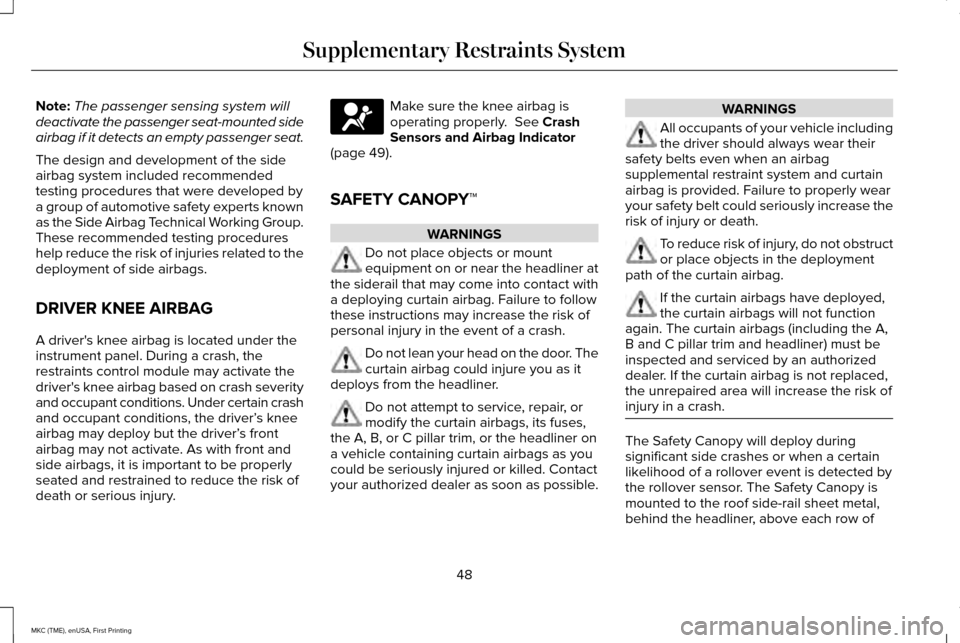
Note:
The passenger sensing system will
deactivate the passenger seat-mounted side
airbag if it detects an empty passenger seat.
The design and development of the side
airbag system included recommended
testing procedures that were developed by
a group of automotive safety experts known
as the Side Airbag Technical Working Group.
These recommended testing procedures
help reduce the risk of injuries related to the
deployment of side airbags.
DRIVER KNEE AIRBAG
A driver's knee airbag is located under the
instrument panel. During a crash, the
restraints control module may activate the
driver's knee airbag based on crash severity
and occupant conditions. Under certain crash
and occupant conditions, the driver’ s knee
airbag may deploy but the driver’ s front
airbag may not activate. As with front and
side airbags, it is important to be properly
seated and restrained to reduce the risk of
death or serious injury. Make sure the knee airbag is
operating properly. See Crash
Sensors and Airbag Indicator
(page
49).
SAFETY CANOPY™ WARNINGS
Do not place objects or mount
equipment on or near the headliner at
the siderail that may come into contact with
a deploying curtain airbag. Failure to follow
these instructions may increase the risk of
personal injury in the event of a crash. Do not lean your head on the door. The
curtain airbag could injure you as it
deploys from the headliner. Do not attempt to service, repair, or
modify the curtain airbags, its fuses,
the A, B, or C pillar trim, or the headliner on
a vehicle containing curtain airbags as you
could be seriously injured or killed. Contact
your authorized dealer as soon as possible. WARNINGS
All occupants of your vehicle including
the driver should always wear their
safety belts even when an airbag
supplemental restraint system and curtain
airbag is provided. Failure to properly wear
your safety belt could seriously increase the
risk of injury or death. To reduce risk of injury, do not obstruct
or place objects in the deployment
path of the curtain airbag. If the curtain airbags have deployed,
the curtain airbags will not function
again. The curtain airbags (including the A,
B and C pillar trim and headliner) must be
inspected and serviced by an authorized
dealer. If the curtain airbag is not replaced,
the unrepaired area will increase the risk of
injury in a crash. The Safety Canopy will deploy during
significant side crashes or when a certain
likelihood of a rollover event is detected by
the rollover sensor. The Safety Canopy is
mounted to the roof side-rail sheet metal,
behind the headliner, above each row of
48
MKC (TME), enUSA, First Printing Supplementary Restraints System
Page 52 of 432
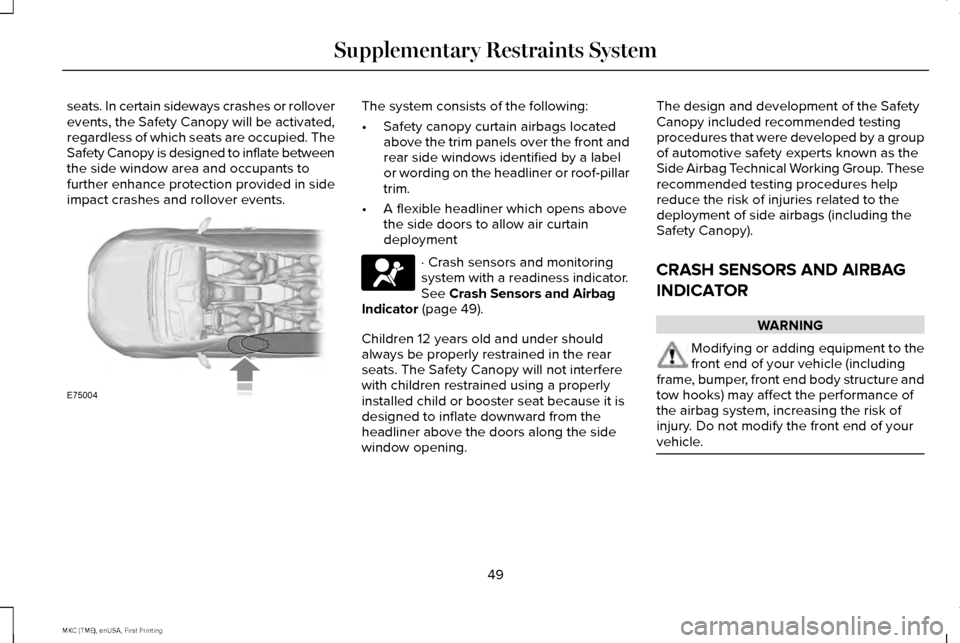
seats. In certain sideways crashes or rollover
events, the Safety Canopy will be activated,
regardless of which seats are occupied. The
Safety Canopy is designed to inflate between
the side window area and occupants to
further enhance protection provided in side
impact crashes and rollover events. The system consists of the following:
•
Safety canopy curtain airbags located
above the trim panels over the front and
rear side windows identified by a label
or wording on the headliner or roof-pillar
trim.
• A flexible headliner which opens above
the side doors to allow air curtain
deployment · Crash sensors and monitoring
system with a readiness indicator.
See Crash Sensors and Airbag
Indicator (page 49).
Children 12 years old and under should
always be properly restrained in the rear
seats. The Safety Canopy will not interfere
with children restrained using a properly
installed child or booster seat because it is
designed to inflate downward from the
headliner above the doors along the side
window opening. The design and development of the Safety
Canopy included recommended testing
procedures that were developed by a group
of automotive safety experts known as the
Side Airbag Technical Working Group. These
recommended testing procedures help
reduce the risk of injuries related to the
deployment of side airbags (including the
Safety Canopy).
CRASH SENSORS AND AIRBAG
INDICATOR
WARNING
Modifying or adding equipment to the
front end of your vehicle (including
frame, bumper, front end body structure and
tow hooks) may affect the performance of
the airbag system, increasing the risk of
injury. Do not modify the front end of your
vehicle. 49
MKC (TME), enUSA, First Printing Supplementary Restraints SystemE75004
Page 102 of 432
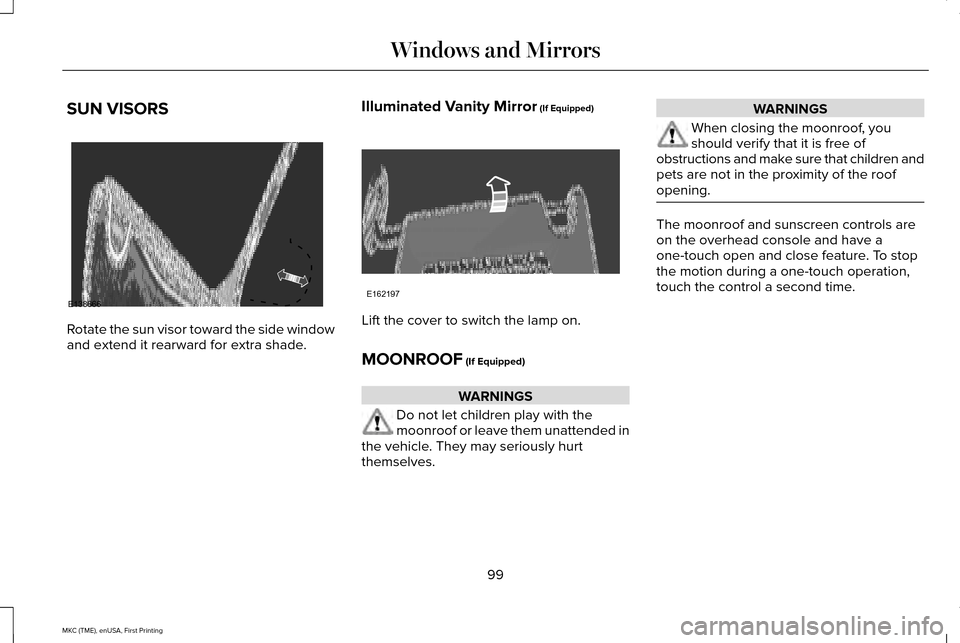
SUN VISORS
Rotate the sun visor toward the side window
and extend it rearward for extra shade.
Illuminated Vanity Mirror (If Equipped) Lift the cover to switch the lamp on.
MOONROOF
(If Equipped)
WARNINGS
Do not let children play with the
moonroof or leave them unattended in
the vehicle. They may seriously hurt
themselves. WARNINGS
When closing the moonroof, you
should verify that it is free of
obstructions and make sure that children and
pets are not in the proximity of the roof
opening. The moonroof and sunscreen controls are
on the overhead console and have a
one-touch open and close feature. To stop
the motion during a one-touch operation,
touch the control a second time.
99
MKC (TME), enUSA, First Printing Windows and MirrorsE138666 E162197
Page 103 of 432

OpenA
VentB
CloseC
Opening and Closing the Moonroof
Touch (A) to open the moonroof. It will stop
short of the fully opened position.
Note: This position helps to reduce wind
noise or rumbling which may happen with
the moonroof fully open. Touch (A) again to
fully open the moonroof.
Touch (C) to close the moonroof. Bounce-Back
The moonroof will stop automatically and
reverse some distance if an obstacle is
detected while closing.
Touch and hold (C) within two seconds of a
bounce-back event to override this function.
Venting the Moonroof
Touch (B) to vent the moonroof.
Touch (C) to close it.
Power Sunscreen CloseA
OpenB
Touch the associated control to operate the
sunscreen.
Press and release the rear of the control to
open the moonroof. If the sunscreen is
closed, it will automatically open before the
moonroof opens. The moonroof will stop
short of the fully opened position.
100
MKC (TME), enUSA, First Printing Windows and MirrorsE144499 E145985
Page 104 of 432
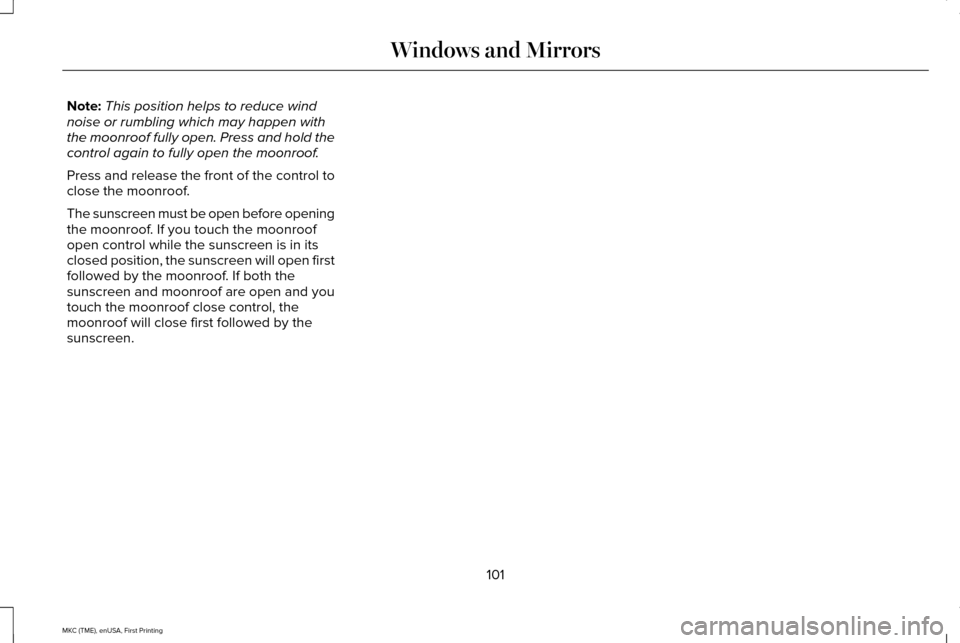
Note:
This position helps to reduce wind
noise or rumbling which may happen with
the moonroof fully open. Press and hold the
control again to fully open the moonroof.
Press and release the front of the control to
close the moonroof.
The sunscreen must be open before opening
the moonroof. If you touch the moonroof
open control while the sunscreen is in its
closed position, the sunscreen will open first
followed by the moonroof. If both the
sunscreen and moonroof are open and you
touch the moonroof close control, the
moonroof will close first followed by the
sunscreen.
101
MKC (TME), enUSA, First Printing Windows and Mirrors
Page 193 of 432
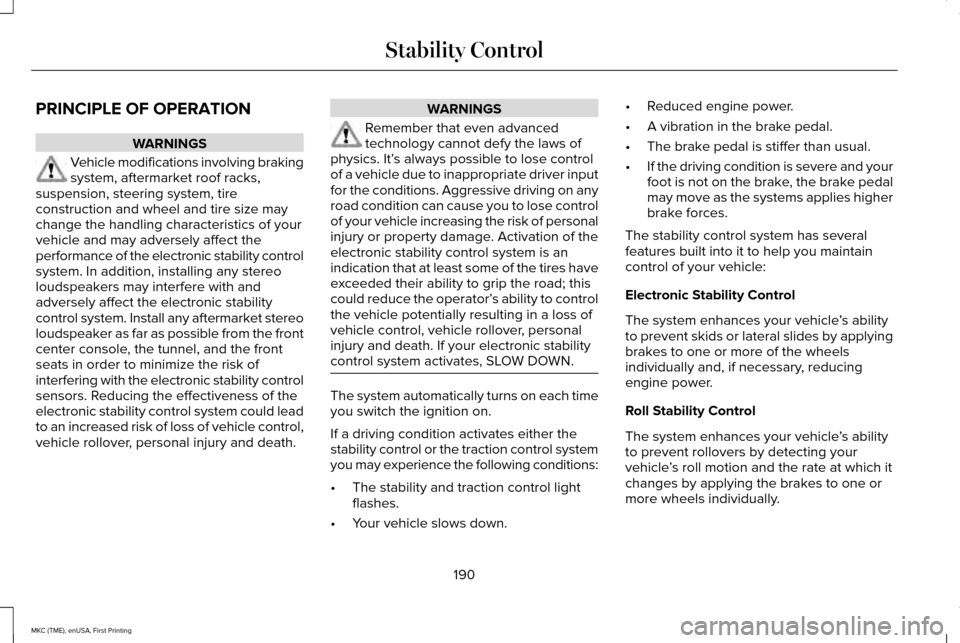
PRINCIPLE OF OPERATION
WARNINGS
Vehicle modifications involving braking
system, aftermarket roof racks,
suspension, steering system, tire
construction and wheel and tire size may
change the handling characteristics of your
vehicle and may adversely affect the
performance of the electronic stability control
system. In addition, installing any stereo
loudspeakers may interfere with and
adversely affect the electronic stability
control system. Install any aftermarket stereo
loudspeaker as far as possible from the front
center console, the tunnel, and the front
seats in order to minimize the risk of
interfering with the electronic stability control
sensors. Reducing the effectiveness of the
electronic stability control system could lead
to an increased risk of loss of vehicle control,
vehicle rollover, personal injury and death. WARNINGS
Remember that even advanced
technology cannot defy the laws of
physics. It’ s always possible to lose control
of a vehicle due to inappropriate driver input
for the conditions. Aggressive driving on any
road condition can cause you to lose control
of your vehicle increasing the risk of personal
injury or property damage. Activation of the
electronic stability control system is an
indication that at least some of the tires have
exceeded their ability to grip the road; this
could reduce the operator’ s ability to control
the vehicle potentially resulting in a loss of
vehicle control, vehicle rollover, personal
injury and death. If your electronic stability
control system activates, SLOW DOWN. The system automatically turns on each time
you switch the ignition on.
If a driving condition activates either the
stability control or the traction control system
you may experience the following conditions:
•
The stability and traction control light
flashes.
• Your vehicle slows down. •
Reduced engine power.
• A vibration in the brake pedal.
• The brake pedal is stiffer than usual.
• If the driving condition is severe and your
foot is not on the brake, the brake pedal
may move as the systems applies higher
brake forces.
The stability control system has several
features built into it to help you maintain
control of your vehicle:
Electronic Stability Control
The system enhances your vehicle ’s ability
to prevent skids or lateral slides by applying
brakes to one or more of the wheels
individually and, if necessary, reducing
engine power.
Roll Stability Control
The system enhances your vehicle ’s ability
to prevent rollovers by detecting your
vehicle ’s roll motion and the rate at which it
changes by applying the brakes to one or
more wheels individually.
190
MKC (TME), enUSA, First Printing Stability Control
Page 197 of 432
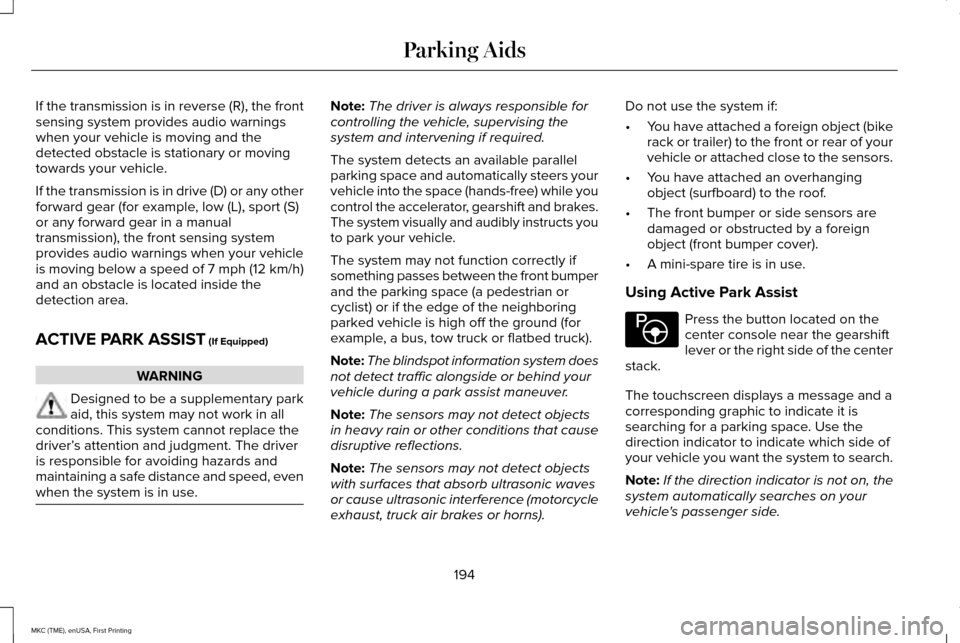
If the transmission is in reverse (R), the front
sensing system provides audio warnings
when your vehicle is moving and the
detected obstacle is stationary or moving
towards your vehicle.
If the transmission is in drive (D) or any other
forward gear (for example, low (L), sport (S)
or any forward gear in a manual
transmission), the front sensing system
provides audio warnings when your vehicle
is moving below a speed of 7 mph (12 km/h)
and an obstacle is located inside the
detection area.
ACTIVE PARK ASSIST (If Equipped)
WARNING
Designed to be a supplementary park
aid, this system may not work in all
conditions. This system cannot replace the
driver’ s attention and judgment. The driver
is responsible for avoiding hazards and
maintaining a safe distance and speed, even
when the system is in use. Note:
The driver is always responsible for
controlling the vehicle, supervising the
system and intervening if required.
The system detects an available parallel
parking space and automatically steers your
vehicle into the space (hands-free) while you
control the accelerator, gearshift and brakes.
The system visually and audibly instructs you
to park your vehicle.
The system may not function correctly if
something passes between the front bumper
and the parking space (a pedestrian or
cyclist) or if the edge of the neighboring
parked vehicle is high off the ground (for
example, a bus, tow truck or flatbed truck).
Note: The blindspot information system does
not detect traffic alongside or behind your
vehicle during a park assist maneuver.
Note: The sensors may not detect objects
in heavy rain or other conditions that cause
disruptive reflections.
Note: The sensors may not detect objects
with surfaces that absorb ultrasonic waves
or cause ultrasonic interference (motorcycle
exhaust, truck air brakes or horns). Do not use the system if:
•
You have attached a foreign object (bike
rack or trailer) to the front or rear of your
vehicle or attached close to the sensors.
• You have attached an overhanging
object (surfboard) to the roof.
• The front bumper or side sensors are
damaged or obstructed by a foreign
object (front bumper cover).
• A mini-spare tire is in use.
Using Active Park Assist Press the button located on the
center console near the gearshift
lever or the right side of the center
stack.
The touchscreen displays a message and a
corresponding graphic to indicate it is
searching for a parking space. Use the
direction indicator to indicate which side of
your vehicle you want the system to search.
Note: If the direction indicator is not on, the
system automatically searches on your
vehicle's passenger side.
194
MKC (TME), enUSA, First Printing Parking AidsE146186